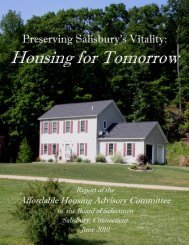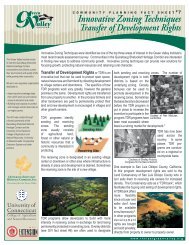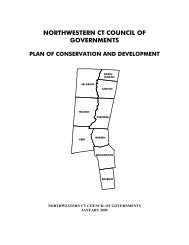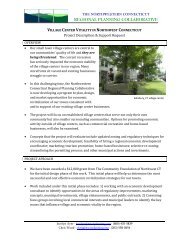Using GIS to Determine Horizon Belts[2]
Using GIS to Determine Horizon Belts[2]
Using GIS to Determine Horizon Belts[2]
You also want an ePaper? Increase the reach of your titles
YUMPU automatically turns print PDFs into web optimized ePapers that Google loves.
Site plans for building or cutting activities in the District must indicated specific<br />
trees <strong>to</strong> be removed; architectural drawings that include wall elevations, roof lines, and<br />
façade materials; and 10 foot <strong>to</strong>pographic con<strong>to</strong>urs for the entire lot. Other components<br />
of a site plan that might be required include 2 foot con<strong>to</strong>urs, the flying of a balloon <strong>to</strong><br />
mark visibility, and field markings of the District by a surveyor. Other information might<br />
be required as well depending on the proposed activity and location.<br />
Future Direction<br />
In August of 2005 the <strong>Horizon</strong>line Conservation District was officially approved<br />
by the <strong>to</strong>wn of Kent. Other Appalachian Trail <strong>to</strong>wns in Connecticut have been waiting <strong>to</strong><br />
see what would happen with this new approach <strong>to</strong> protecting scenic ridges, and may<br />
follow suit. Some <strong>to</strong>wns outside the Appalachian Trail corridor are implementing or<br />
considering this methodology as well. Other areas of the country could benefit from this<br />
approach <strong>to</strong> protecting scenic ridges. Western states now feature some of the highest<br />
growth rates in the nation, with ridges that are often exposed with sparse tree cover.<br />
Indeed, the horizon belt methodology could prove beneficial for anywhere that scenic<br />
ridges and development patterns seem destined <strong>to</strong> collide.<br />
Developing scenic ridges threatens more than local <strong>to</strong>wn character. The<br />
recreational experience on trails and watercourses that come in close proximity <strong>to</strong> private<br />
lands, such as is the case with the Appalachian Trail, can be negatively impacted by the<br />
sight of a “castle on a hill.” Delineating the most obtrusive zone of a viewshed could<br />
have regional applications that serve both land and water recreationists.<br />
By focusing on the most obtrusive part of a viewshed, horizon belts allow for<br />
compromise. A homeowner could locate a house on a portion of a ridge that affords a


![Using GIS to Determine Horizon Belts[2]](https://img.yumpu.com/38917728/14/500x640/using-gis-to-determine-horizon-belts2.jpg)




